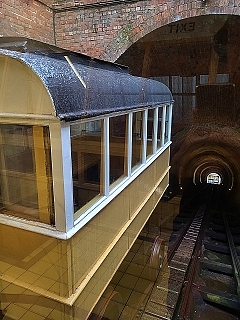An unusual Victorian funicular still working by the sea
STEEP CLIFFS OVERLOOK Hastings Old Town and the beach immediately east of it. Although there are roads that lead from these parts of Hastings to the rest of the town on top of the cliffs, a more interesting way of travelling between the bottom and the top of the cliffs is by using either the East Hill Lift or the older West Hill Lift. Both are funiculars. We travelled up and down on the West Hill Lift, which travels between the west end of the Old Town and the ruins of Hastings Castle high above on the top of the cliff.

The West Hill Lift (‘WHL’) is 500 feet long and ascends a height of 170 feet, a gradient of 33% (1 in 3). It comprises two tracks, each 6 feet in gauge. It is powered by electricity. The two carriages, which can each hold up to 16 people are raided and lowered along the tracks by steel cables attached to them. They are equipped with a mechanism that automatically applies brakes to the wheels should the cable break. I did not know this when we made a trip up and down the cliff in the creaky old carriages, which are those that were supplied when the system was originally installed.
The construction of the WHL began in 1899 (the year that the Eiffel Tower was built). But it was only completed in 1891, when the cable winders were operated by a gas-powered engine. The funicular system was built by Messrs A H Holme & C W King of Liverpool, who later built the Snowdon Mountain Railway. In 1894, after the Hastings Lift Company went ‘bust’, the WHL was taken over by the Hastings Passenger Lift Company. This company ran it until 1947, when the Lift was bought by Hastings Borough Council. In 1924, the gas engine was replaced by a diesel engine, which was later replaced by an electric motor (in 1971).
Despite having been refurbished in 1991, the WLF still operates with its original 1890s carriages. Admission to these is via an old-fashioned metal turnstile operated by the ticket seller. Apart from looking archaic, a special feature of the WHL is that most of it travels in a brick-lined tunnel burrowed through the cliff. Its neighbour, the East Hill Lift, runs through an uncovered cleft cut in the cliffs. Apparently, few other funiculars in Britain were built, like the WHL, to run through tunnels, and those that were, are no longer in use.
Although Hastings is not nearly as elegant as other British seaside towns such as Eastbourne and Brighton, it is an intriguing place rich in places of historical and visual interest. The existence of the superb Hastings Contemporary art gallery and the two working funiculars adds to the fascination of the place. It is not a place to be ‘sniffed at’.



